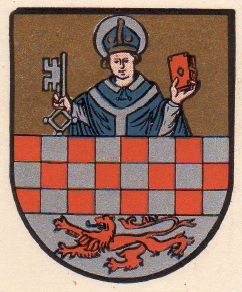Rönsahl: Difference between revisions
Jump to navigation
Jump to search
Knorrepoes (talk | contribs) m (Text replacement - "/Arms of " to "/Arms (crest) of ") |
Knorrepoes (talk | contribs) m (Text replacement - "{{media}}" to " {{de1}} {{media1}}") |
||
| Line 24: | Line 24: | ||
The arms show the bar taken from the arms of the Counts of the Mark, who ruled the area in the medieval times. The upper half shows the bust of St. Servatius, the local patron saint. The local St. Servatius well was a famous place of pilgrimage. The base shows the lion of the Counts of Berg, who also ruled part of the area for a long time. | The arms show the bar taken from the arms of the Counts of the Mark, who ruled the area in the medieval times. The upper half shows the bust of St. Servatius, the local patron saint. The local St. Servatius well was a famous place of pilgrimage. The base shows the lion of the Counts of Berg, who also ruled part of the area for a long time. | ||
{{ | |||
{{de1}} | |||
{{media1}} | |||
[[Civic Heraldry Literature - Germany|'''Literature''']]: Meijer, 1940 | [[Civic Heraldry Literature - Germany|'''Literature''']]: Meijer, 1940 | ||
Revision as of 11:43, 26 December 2022
This page is part of the German heraldry portal Deutsche Wappensammlung |
Heraldry of the World |
|
German heraldry:
|
Selected collector's items from Germany:
|
RÖNSAHL
State : Nordrhein-Westfalen
District (Kreis) : Märkischer Kreis (1969-1975 Lüdenscheid, until 1969 Altena)
Incorporated into: 1969 Kierspe
| German | |
| English | No blazon/translation known. Please click here to send your (heraldic !) blazon or translation |
Origin/meaning
The arms were granted on October 17, 1935.
The arms show the bar taken from the arms of the Counts of the Mark, who ruled the area in the medieval times. The upper half shows the bust of St. Servatius, the local patron saint. The local St. Servatius well was a famous place of pilgrimage. The base shows the lion of the Counts of Berg, who also ruled part of the area for a long time.
Literature: Meijer, 1940


